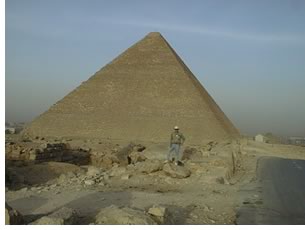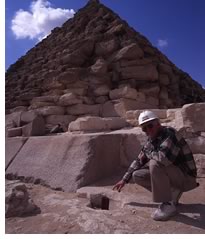

05/2005
Convention presentation details process from 4,500 years ago
by Russell Boniface
How would you build the Great Pyramid?
That question was pondered by the Los Angeles’ Daniel, Mann, Johnson and Mendenhall-Holmes & Narver, the global firm that has been involved in myriad public works projects, including the renovation of the Pentagon. Their answer: program management. Translation: A lot of planning.
 Craig B. Smith, chief operating officer of DMJM H&N, has written
a compelling book entitled How the Great
Pyramid Was Built. He will offer
a forensic analysis of the Great Pyramid’s construction and planning
during the AIA National Convention in Las Vegas on Friday, May 20, 4–5:30
p.m. in his seminar called “Stairsteps to the Gods: Design/Construction
of the Great Pyramid.’’
Craig B. Smith, chief operating officer of DMJM H&N, has written
a compelling book entitled How the Great
Pyramid Was Built. He will offer
a forensic analysis of the Great Pyramid’s construction and planning
during the AIA National Convention in Las Vegas on Friday, May 20, 4–5:30
p.m. in his seminar called “Stairsteps to the Gods: Design/Construction
of the Great Pyramid.’’
In the book, Smith details the program management of the Great Pyramid 4,500 years ago. He provides an interesting history of the culture and lifestyle of the builders and explains the mathematics of the engineering, but the crux of the book is Smith’s perspective of the Great Pyramid as a large, well-planned public works project.
Build like an Egyptian
The Great Pyramid was built as a tomb for the Egyptian pharaoh Khufu
at a time when the pharaohs believed pyramids would send their spirits
to the heavens. Approximately 90 pyramid structures of various sizes
are preserved in Egypt, but it’s the Great Pyramid that stands
out. Consisting of 2.3 million blocks of limestone and granite, some
weighing as much as 20 tons, the pyramid's base covers 13 acres, and
its sides rise at a 51-degree slope to a height of 451 feet. It is
oriented almost precisely north to south.
Smith, then principal in charge of DMJM, was responsible for solving program management issues for an ongoing Northern California transit project that included bringing in a new organization of construction managers, estimators, schedulers, and inspectors while ensuring that the work continued without a hitch. This meant ensuring the necessary resources, tools, and logistics. He sat in an Oakland hotel room on a rainy day and asked himself, “How did the ancient Egyptians deal with these same problems?” The Northern California transit project went smoothly, he thought, but what about the Great Pyramid?
 Before
he knew it, he had to know first-hand. Computer models and trips to the
Giza plateau in Egypt followed to explore the Great Pyramid. “I
first visited Giza in 1980,” says Smith, “and like any tourist,
stared up at the mammoth structure of the Great Pyramid—as tall
as a 40-story building. Like every other tourist who has visited the
site, I asked myself, ‘How did they do that?’ Little did
I know that I would later spend a good 10 years researching, thinking,
and talking about it.”
Before
he knew it, he had to know first-hand. Computer models and trips to the
Giza plateau in Egypt followed to explore the Great Pyramid. “I
first visited Giza in 1980,” says Smith, “and like any tourist,
stared up at the mammoth structure of the Great Pyramid—as tall
as a 40-story building. Like every other tourist who has visited the
site, I asked myself, ‘How did they do that?’ Little did
I know that I would later spend a good 10 years researching, thinking,
and talking about it.”
The thinking was that viewing the Great Pyramid with a project-management perspective would offer new insights into how it was built, plus provide a case study on the construction process, design, and engineering that would lead to building such a large structure.
Smith says that the more he thought about it, the more he became convinced that studying the Great Pyramid would show that it could not have been built without some form of organized program management. “As splendid as the architecture and design of the Great Pyramid is, one of the most impressive accomplishments of the ancient Egyptians has to be the logistics—the marshalling of all of the manpower, resources, tools, and materials to accomplish this gigantic project at a remote site in the desert within the life span of the pharaoh.”
Learning from mistakes
The Great Pyramid is a natural development and improvement over two prototypes:
the Step Pyramid, which looked like a staircase on all sides, and the
Bent Pyramid, a failed attempt at a perfectly proportioned pyramid
structure. With the Great Pyramid, the ancients learned from their
mistakes and did more planning. Blocks of stone were stacked just right
until the dimensions were accurate according to plan. Finishing the
job were blocks of casing limestone.
“The man who planned Khafu’s pyramid, Hemiunu, certainly studied the earlier efforts, seeking to discover what worked and what pitfalls to avoid,” says Smith. “He was no doubt aware of past project failures—such as cracking at the Bent Pyramid. It is logical to assume that he made efforts to learn from the past.”
Smith maintains that the ancients had a superb grasp of math, a vital discipline necessary to perform large construction works in ancient Egypt. They were familiar with spatial concepts, triangles, ratios, volumes, and angles. The Egyptians were able to calculate dimensions, the weight of large structures, and the number of blocks required for a slope. They knew about division, fractions, square roots, and a way to determine the radius of a circle.
But what is more amazing, he believes, is how project management and quality control skills were applied by the ancient Egyptians to construct the Great Pyramid. Evidence discovered from the Giza site and from building sites of later dynasties support the theory, says Smith, that Hemiunu, the project manager, would have had to have drafted an extensive design and project management plan, all written on clay tablets or papyri. This would have included drawings and plans of specifications, land surveys, and irrigation strategies. The plan would have also included a work breakdown with a schedule, cost estimates, methods on how to procure stones and tools, and safety techniques. Payroll and attendance records, as well as requisitions of stone blocks for the quarries were also believed to have been scribed by members of Hemiunu’s team.
There is even considerable evidence, according to the book, that the ancient Egyptians put identification numbers on the stone blocks indicating size and where to place them, as if in accordance with a pre-arranged plan. Smith also stresses that the labor force, which included stonecutters and stonemasons, were not slaves but farmers who were available during the torrential rainy season.
In the book, Smith also breaks down the Great Pyramid’s work force by skill of 30,000–40,000 workers, based on various calculations. He estimates the number of quarry operators, stone haulers, ramp laborers, and members of the administrative and program management group. Other estimates include the number of blocks delivered and installed per day via mud ramps, the number of trips to the quarry per day, the length of the work day and work week, the amount of food distributed, and the amount of housing needed.
Job satisfaction
Although the tools and material have changed, it appears that if architects
built the Great Pyramid today, they might use a similar program management
approach to that of the ancients. Perhaps planning for a large-scale
structure hasn’t changed much over time.
And the feeling of reward evidently was the same for the ancients as it would be for architects today. As Smith points out in his book, concealed “graffiti” left behind on stones, only recently discovered deep inside the Great Pyramid, reveals the names of those involved in its building. Smith writes that they knew in their hearts it was the result of their efforts. If they only could have known in fact, four-and-a-half millennia later: Now that’s job satisfaction!
Copyright 2005 The American Institute of Architects.
All rights reserved. Home Page ![]()
![]()
